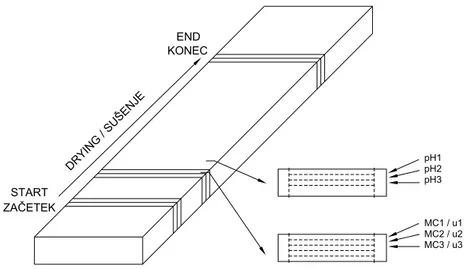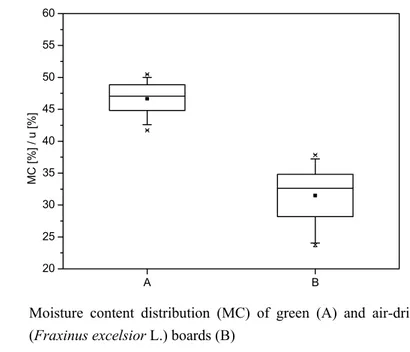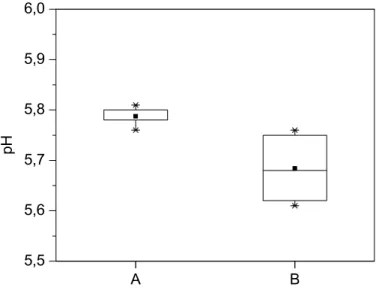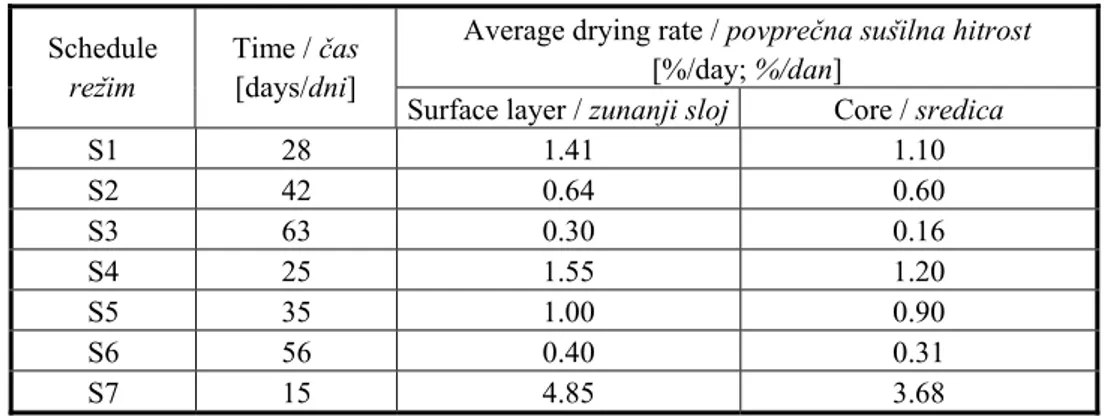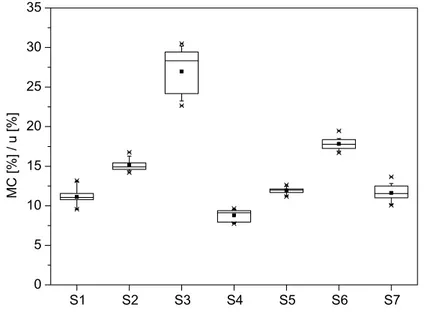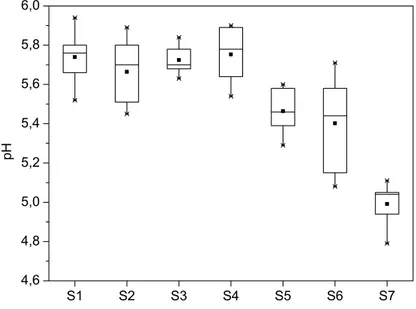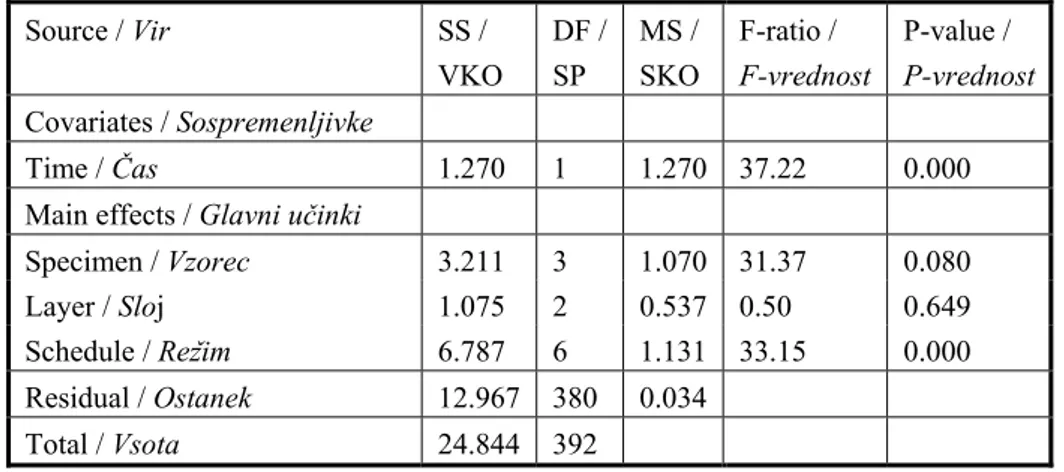GDK 847.275
Prispelo / Received: 18.09.2003 Izvirni znanstveni članek
Sprejeto / Accepted: 03.11.2003 Original scientific paper
CHANGES OF ASHWOOD pH-VALUE DURING
CONVENTIONAL DRYING
Aleš STRAŽE*, Sandi TORKAR**, Vesna TIŠLER*, Željko GORIŠEK*
Abstract
Changes of pH of sawn wood during conventional drying were studied. Green ashwood boards (Fraxinus
excelsior L.), 25.4 mm in thickness, were exposed to 1 month air drying and to kiln drying using 7 schedules,
reached by varying temperature (20°C, 30°C and 65°C) and relative air humidity (33% to 90%). Wood samples for pH and moisture content (MC) determination were taken in successive time interval at 3 board's depths (1/10, 1/3 and 1/2 of thickness). MC was established gravimetrically. pH-value determination of solid wood water system by suspending wood dust into distilled water was used. The lowest used temperature and duration of drying procedure had not significant influence on wood pH. Wood acidification was confirmed at higher drying temperatures (30°C and 65°C), particularly with lower drying rates and prolongation of the procedure. Among all the factors, drying temperature had the greatest impact on the pH-value of wood.
Key words: ash-wood, pH-value, drying, drying conditions
SPREMINJANJE pH-VREDNOSTI JESENOVINE PRI KONVEKTIVNEM
SUŠENJU
Izvleček
Raziskovano je bilo spreminjanje pH-vrednosti lesa med procesom naravnega in komorskega sušenja žaganega lesa. Les velikega jesena (Fraxinus excelsior L.), debeline 25mm, je bil sušen pod sedmimi konstantnimi
sušilnimi režimi, z uporabo 3 temperatur (20°C, 30°C in 65°C) in relativnih zračnih vlažnosti med 33% in 90%.
Vzporedno je potekalo zračno sušenje jesenovine v spomladanskih kontinentalnih klimatskih razmerah.
Določanje pH vrednosti in lesne vlažnosti je potekalo z odvzemanjem vzorcev v zaporednih časovnih intervalih
na 3 globinah žaganic (1/10, 1/3 in 1/2 debeline). Lesna vlažnost je bila določena gravimetrično, pH-vrednost
lesa pa z vodno ekstrakcijsko metodo. Vrednosti pH jesenovine se pri sušenju z najnižjo temperaturo niso
spremenile. Z višanjem temperature sušenja (30°C in 65°C) se je pH jesenovine značilno zmanjšala, še posebej
pri daljšem sušenju in ob uporabi vlažnejših klimatskih razmer v komori. Temperatura sušenja je imela med vsemi dejavniki najbolj izrazit vpliv na pH lesa.
Ključne besede: jesenovina, pH-vrednost, sušenje, sušilne razmere
* Biotehniška fakulteta, Oddelek za lesarstvo, Rožna dolina, c. VIII/34, 1000 Ljubljana, SVN ** Novem d.o.o., Ložnica pri Žalcu 53a, 3310 Žalec, SVN
VSEBINA
CONTENTS
1
INTRODUCTION
... 109
UVOD
2
MATERIALS AND METHODS
... 110
MATERIAL IN METODE
3
RESULTS
... 113
REZULTATI
4
DISCUSSION
... 118
DISKUSIJA
5
CONCLUSIONS
... 120
ZAKLJU
Č
KI
6
POVZETEK
... 120
7
REFERENCES
... 123
LITERATURA
1
INTRODUCTION
UVOD
The pH-value of wood is interesting from many aspects, such as wood protection, gluing, surface treatment, mechanical treatment as well as hydrothermal procedures. Hence, the acidity of wood has been referred to in a number of publications (KRILOV / GREF 1986; PRASETYA / BÖHNER / ROFFAEL 1992; TORELLI / ČUFAR 1995; LJULKA / SERTIĆ / JIROUŠ-RAJKOVIĆ 1996; HUMAR / PETRIČ / POHLEVEN 2001; TIŠLER / MALNARIČ, 2002).
Hydrothermal treatment has, just as common drying procedures, a great influence on physical and chemical properties of wood, where only in some specific cases of quality reduction an attention is attracted to the latter. The so far carried out research has shown that solid wood water system releases, during moisture removal from wood tissues, small and various amounts of weak organic acids into the surrounding atmosphere (PACKMAN 1960), and usually gives to the wood an increasingly acidic character. Suchlike changes of wood acidity directly affect corrosion of metals attached to the wood (ARNI / COCHRANE / GRAY 1965a, 1965b; HILLIS / MCKENZIE 1964), or similarly with maintaining of humid drying conditions to the enclosed metal kiln driers.
Much research on the pH changes of wood during drying has been carried out during several wood discolouration problems. The dependency of bacteria, moulds and other fungi growth on pH-values of wood were determined and optimal pH-values for various fungi and wood species were confirmed (WARD / GROOM 1983; BAUCH et al. 1985, 1991). The ability to regulate the pH-value of the solution was also established in case of fresh wood infected with bacteria during its water storage period. Latter on, changed pH-value of wood tissue induced specific colouring reactions of contents of parenchyma cells (BERNDT / LIESE 1973; LIESE 1992). Encymatic staining, as a possible colouring mechanism in fresh sapwood during storage or slow drying at low temperatures, has, according to MCEVILY / IYENGAR (1992), an optimum pH range between 4 and 7. The optimal pH-value of 4.0 was found out also in case of iron-tannic colouring reaction, known at wood-metal attachments during kiln drying of species, reached with tannic compounds (SANDERMANN / LUETHGENS 1953; KOCH et al. 2000). Many mechanisms of wood discolouring at normal temperature drying are interpreted with
combination of hydrolytic and subsequent condensation reactions on wood compounds, where the pH of the medium highly affect the rate of the first one (KOLLMANN et al. 1951; KOLLMANN / FENGEL 1965; GORIŠEK 1995).
Increasingly important are the environmental effects arising from timber drying due to discharges of hazardous compounds, volatile organic compounds (VOC), odorous substances, aqueous condensates and inorganic contaminants. In this respect, the focus was more on gaseous emissions (LAVERY / MILOTA 200; MCDONALD et al. 2002), whereas recently, due to the industrial liquids disposal restrictions, liquid condensates attracted the attention as well (DARE / RILEY 2003).
To the best knowledge of the authors of this paper, reports on the influence of drying procedure on pH changes of wood during normal temperature drying are very rare or barely mentioned in the literature (PACKMAN 1960; SANDERMAN / ROTHKAMM 1959). Thus we were interested in what happens to pH of wood during various drying procedures in normal temperature range and in the influence of drying parameters, especially the drying rate and its impact on the moisture content and moisture content gradient in timber cross section, as well as on the duration of the procedure. Owing to the known discolouration problems during conventional normal temperature drying (STRAZE et al. 2003) and to its industrial importance, European ashwood (Fraxinus
excelsior L.) timber was used. Since many methods of wood pH determination were
applied, a general used procedure with suspending wood dust into distilled water (STAMM 1961) was tested for experimental analysis.
2
MATERIALS AND METHODS
MATERIAL IN METODE
2.1 SAMPLE PREPARATION
PRIPRAVA MATERIALA, VZORČENJE
Four logs of European ashwood (Fraxinus excelsior L.), 1m in length, were cut at breast high (h=1.3m) from standing trees. Outer flat sawn boards, 25.4mm in thickness, were sawn from the logs and sampled into 8 parallel specimens.
2.2 DRYING PROCEDURES
SUŠILNI POSTOPKI
The specimens, 600mm in length, were smeared immediately with waterproof paints at their cut ends, to prevent rapid water evaporation. Afterwards, seven parallel specimens were contemporaneously dried in laboratory kiln driers using various temperature (T) and relative air humidity (RH), establishing different drying rates (Tab. 1). The air velocity of 0.5m/s remained constant during the entire drying process. The drying process was controlled by wood moisture content (MC), where target MC was predefined to 1-2% more than the equilibrium moisture content (EMC) of the kiln.
Simultaneously, air drying of the remaining specimens during the kiln drying at local timber yard was proceeded. Therefore, specimens were dried for a 1-month period under early spring continental climatic conditions.
Table 1: Drying schedules (S1 to S7) with corresponding temperature (T), relative humidity (RH) and established wood equilibrium moisture content (EMC)
Preglednica 1: Sušilni režimi (S1 do S7) s pripadajočimi temperaturami sušenja (T),
relativnimi zračnimi vlažnostmi (ϕ) in doseženimi ravnovesnimi lesnimi
vlažnostmi (ur)
Schedule / Režim T [°C] RH / ϕ [%] EMC / ur [%]
S1 33 ± 2 7 S2 65 ± 2 12 S3 20 ± 1 90 ± 2 21 S4 33 ± 2 6.5 S5 65 ± 2 11 S6 30 ± 1 90 ± 2 20 S7 65 ± 1 85 ± 2 15
2.3 DETERMINATION OF MOISTURE CONTENT AND PH-VALUE
DOLOČANJE VLAŽNOSTI IN PH-VREDNOSTI LESA
The MC measurements, based on the oven dry method (prEN 13183-1), were applied by successive weighing of specimens from the beginning to the end of the drying procedure. During the drying, successive sampling for MC-gradient determination was carried out at predefined MC decrease by slicing the sawn samples (l=20mm) from the board at three board’s depths (1/10, 1/3 and 1/2 of the thickness) (Fig. 1).
Simultaneously with MC-gradient sampling, samples for pH-value determination were taken. The pH of wood was determined at the same predefined MC decrease and at the same board’s depths as MC-gradient, using a modified comparative extraction method by STAMM (1961) (Fig. 1). Sawn wood slices, from depths at 1/10, 1/3 and 1/2 of the thickness, were shaven into sawdust, which could pass through a 40-mesh screen. Sawdust of 2.0g was then immediately added to 50 ml of boiling de-ionized water (pH=6.5) and stirred for 5 minutes in an Erlenmayer flask with reflux. The mixture was standing in the closed flask for 30 minutes and was then rapidly cooled to room temperature. Afterwards, the extract was filtered and pH of the solution was measured with glass electrode.
MC1 / u1 MC2 / u2 MC3 / u3 pH1 pH2 pH3 START END DRYIN G / SU ŠENJ E ZAČETEK KONEC
Figure 1: Sampling for determination of MC, MC-gradient and pH-value
Slika 1: Odvzem vzorcev za določanje lesne vlažnosti (u), vlažnostnega gradienta
3
RESULTS
REZULTATI
3.1 MOISTURE CONTENT AND PH OF GREEN AND AIR-DRIED ASHWOOD
VLAŽNOST IN PH-VREDNOST SVEŽE IN NARAVNO POSUŠENE JESENOVINE Wood average MC during 1 month air-drying of ashwood boards in outside timber yard fell from 46.7 % to 31.5 % (Fig. 2). Green ashwood boards had uniform MC distribution (coefficient of variation: CV=5.3%), whereas MC gradient at the end of the procedure varied from 25.1% at the outside layer (1/10 of thickness) to 34.4% in the core (1/2 of thickness; CV=13.6%).
Green samples had also narrow pH distribution around mean of 5.8 (CV=0.3%), without significant difference between surface and core layer of specimen (Fig. 3). The pH of ashwood after air drying followed slight decrease to the average value of 5.7 at wider distribution (CV=1.0%) (Fig. 3). Higher, but insignificantly different pH values were present near the surface of the boards, where inversely lower final MC was reached.
A B 20 25 30 35 40 45 50 55 60 MC [% ] / u [% ]
Figure 2: Moisture content distribution (MC) of green (A) and air-dried ashwood
(Fraxinus excelsior L.) boards (B)
Slika 2: Porazdelitev lesne vlažnosti (u) v sveži (A) in zračno suhi jesenovini
A B 5,5 5,6 5,7 5,8 5,9 6,0 pH
Figure 3: pH distribution of green (A) and predried (B) ashwood boards (Fraxinus
excelsior L.)
Slika 3: Porazdelitev pH-vrednosti v sveži (A) in zračno osušeni jesenovini
(Fraxinus excelsior L.) (B)
3.2 KILN DRYING KINETICS
KINETIKA ŠARŽNEGA KONVEKCIJSKEGA SUŠENJA
The fastest drying procedure, nearly two-fold shorter in comparison to other used procedures (t=15days), was under drying schedule S7 (Tab. 2). High drying rate was achieved during the whole cross section of specimens, and lead to uniform final MC. Moderate drying rate (∆MC/∆t > 1%/day) was assured at drying temperatures of 20°C and 30°C using low relative air humidity (RH=33%; S1 and S4). Low final MC, narrowly distributed over sample’s cross section (Fig. 4), was reached between 3 and 4 weeks. Slower (∆MC/∆t ≤ 1%/day) but still uniform drying was achieved using moderate RH (RH=65%) at these two temperatures (S2 and S5). The worst drying conditions were present at drying schedules S3 and S6, where drying rate fell bellow 0.5%/day in the surface- as well as in the core-layer. The last two schedules led to uneven drying across the samples cross sections, especially under the drying schedule S3 (t=56days), which resulted in wide distribution of final MC over the thickness of boards.
Table 2: Drying time and average drying rate in surface- (1/10 of thickness) and in core-layer (1/2 of thickness) of specimens at various drying schedules (S1 to S7)
Preglednica 2: Čas sušenja in povprečna sušilna hitrost površine (1/10 debeline) in sredice
vzorcev (1/2 debeline), sušenih z različnimi režimi sušenja (S1 do S7)
Average drying rate / povprečna sušilna hitrost
[%/day; %/dan] Schedule
režim
Time / čas
[days/dni]
Surface layer / zunanji sloj Core / sredica
S1 28 1.41 1.10 S2 42 0.64 0.60 S3 63 0.30 0.16 S4 25 1.55 1.20 S5 35 1.00 0.90 S6 56 0.40 0.31 S7 15 4.85 3.68
3.3 END MOISTURE CONTENT OF KILN-DRIED ASHWOOD
KONČNA VLAŽNOST ŠARŽNO KONVEKCIJSKO POSUŠENE JESENOVINE
Use of various drying schedules (S1 to S7) led to different drying rates and corresponding duration of procedures (Tab. 2). Target final MC was predefined by individual EMC of drying chamber (Tab. 1), and was determined as the mean value of three observing specimen’s layers.
The lowest final MC (8.8%) was reached in boards dried under schedule S4, whereas values around 11% were reached in boards dried under schedules S1, S5 and S7. Moderate final MC, namely between 15 and 20%, was established in boards dried under schedules S2 and S6, and the highest final MC (27%) at boards dried under drying schedule S3 (Fig. 4). In contrast to the former drying procedures, widely distributed final MC was established in specimens dried under schedule S3. In the last instance, slightly lower final MC was present in the surface layer of specimens (20%≤MC≤25%), whereas final MC in the core layer reached only values around fiber saturation point (FSP).
S1 S2 S3 S4 S5 S6 S7 0 5 10 15 20 25 30 35 MC [% ] / u [% ]
Figure 4: Final MC distribution of ashwood dried under various drying procedures (S1 to S7)
Slika 4: Porazdelitev končne lesne vlažnosti (uk) jesenovine po šaržnem
konvekcijskem sušenju (S1 do S7)
3.4 PH OF KILN-DRIED ASHWOOD
PH-VREDNOST ŠARŽNO KONVEKCIJSKO POSUŠENE JESENOVINE Kiln drying of ashwood at low temperature (T=20°C; S1, S2 and S3) did not cause any significant pH changes. The pH remained in all cases, likewise in core- and surface-layer of specimens, between 5.6 and 5.8, similar to values in green and air-dried wood (Fig. 5). Neither did the raising of temperature to 30°C at low RH (S4) cause any acidification of wood. Reduced drying potential at medium used temperature (S5; 30°C/65%) prolonged the drying time (t=35days) and also provoked significant decrease of wood pH to values around mean of 5.5. The slowest drying at the same temperature (S6; t=56days) caused still higher acidification of the wood tissue. In the last case, end pH of mean around 5.4 was achieved, but with significantly lower values in the core of specimens (pH=5.2), whereas surface did not suffer such distinctive acidification (pH=5.6). The greatest pH
decrease occurred in specimens dried under schedule S7 (surface: pH=4.8; core: pH=5.0), when the highest temperature (T=65°C) was used. In the latter instance, less variation of pH over the cross section of specimens was established in comparison to the drying under schedule S6. S1 S2 S3 S4 S5 S6 S7 4,6 4,8 5,0 5,2 5,4 5,6 5,8 6,0 pH
Figure 5: Final pH-value distribution of ashwood dried under various drying procedures (S1 to S7)
Slika 5: Porazdelitev končne pH-vrednosti jesenovine po šaržnem konvekcijskem
sušenju (S1 do S7)
Multivariable statistics analysis on influencing effects (p≤0.05) to the pH of ashwood confirmed the drying schedule (S1 to S7) and consecutive drying time (t) to be significant influencing variables (Tab. 3). Depth of the specimens (core and surface layer) was not confirmed as the general influencing variable to the resulting pH, and has significant influence only in particular exceeding cases (S6 and S7) (Tab. 3).
Table 3: Multivariable analysis of variance (p≤0.05) for pH of ashwood dried under various drying schedules (SS-sum of squares, DF-degrees of freedom, MS-mean square, F-ratio, p-value)
Preglednica 3: Multivariantna analiza variance (p≤0.05) za pH-vrednosti jesenovine
po šaržnem konvekcijskem sušenju (VKO-vsota kvadratov odklonov, SP-stopnje prostosti, SKO-srednji kvadratni odklon, F-vrednost, p-vrednost) Source / Vir SS / VKO DF / SP MS / SKO F-ratio / F-vrednost P-value / P-vrednost Covariates / Sospremenljivke Time / Čas 1.270 1 1.270 37.22 0.000
Main effects / Glavni učinki
Specimen / Vzorec 3.211 3 1.070 31.37 0.080 Layer / Sloj 1.075 2 0.537 0.50 0.649 Schedule / Režim 6.787 6 1.131 33.15 0.000 Residual / Ostanek 12.967 380 0.034 Total / Vsota 24.844 392
4
DISCUSSION
DISKUSIJA
Applicability and accuracy of the used experimental methodology was confirmed by comparing the results with other similar researches. In good agreement are the determined pH-values of ashwood in green state (pH=5.8) with the findings of SANDERMANN and ROTHKAMM (1959), by using similar experimental procedure. The authors determined the pH between 5.9 and 6.0 for the European ashwood (Fraxinus
excelsior L.) in green condition, which decreased to pH of 5.8 at room temperature and at
EMC of 20%.
It is of interest to note the small but significant decrease of pH already after 1-month air drying to the final MC near FSP. The result confirms the beginning of wood acidification already in the free water range, which was suggested by PACKMAN (1960). The author
described moistened wood as a complex buffer solution containing weak acids and their salts, especially acetic and formic acid, where the acid may be liberated during storage under humid conditions. In the storage of Sitka spruce, beech and birch in humid climate his experiment showed a balance of freed liberated acetic acid from wood with losses of combined acetyl groups in wood tissue. This indicated that the acid was liberated by the process of hydrolysis, which took place under the damp conditions of storage and by which the acetyl groups were split off from their association with hemicelluloses in the wood.
Almost the same pH decrease, compared with air drying, was achieved at the end of kiln drying using low temperature (S1, S2 and S3). Various drying rates at used temperature had no significant influence on pH changes of wood, also in case of long, 2-month drying under schedule S3. It is necessary to emphasize that wood tissue dried under schedule S3 has final MC still near FSP, and therefore still possesses high potential for hydrolytic processes.
In contrast to low temperature drying (S1, S2 and S3), significant influence of drying rate and consecutively drying time on pH of wood was established using moderate temperature (T=30°C; S4, S5 and S6). During drying under S4, high drying rate, causing short drying time, was presumably the reason for the same pH changes of wood in comparison to air-drying and low temperature drying (S1, S2 and S3). More humid conditions in drying chamber, using the same temperature (T=30°C), decreased drying rate under S5, and especially during drying under schedule S6. Comparison of drying times of S5 and S6 specimens to low temperature drying, where the same RH in chamber was maintained (S2 and S3), did not indicate significant difference, whereas significant pH decrease of wood was established during the latter procedures (S5 and S6). It is of importance that high final MC of specimens dried under schedule S6 still gives strong potential for further hydrolytic reactions in wood, and therefore the high probability of additional decreasing of pH value of wood.
According to PACKMAN (1960), rising of temperature significantly influence the hydrolytic reactions in wood and therefore the rise in the rate of acid evolution, where considerable quantities of acid can pass from the wood into the surrounding damp atmosphere. The author also suggests that humid atmosphere holds favourable wet
conditions in wood, needed for hydrolytic processes, and that it inhibits transport of volatile, free acid from wood into the surrounding. Combining the statements, it can be inferred that in short drying time and presumably in the allowed transport of free acid from the wood, owing to low surrounding RH, the raised temperature did not affect pH changes of wood dried under S4. Opposite conditions were probably the reason for a significant decrease of final pH of wood in the cases of S5 and S6 drying.
Significant influence of temperature on the hydrolytic processes in wood is the most pronounced in specimens dried under schedule S7. In this case, relatively humid surrounding at high temperature caused the greatest and even acidification of wood in the shortest drying time.
5
CONCLUSIONS
ZAKLJU
Č
KI
The research confirmed the impact of drying conditions on the pH of ashwood. At room temperature drying (20°C), duration and drying rate do not significantly affect the pH of ashwood, whereas rising of drying temperature enlarge their influence. High temperature drying using humid climatic conditions provokes acidification of wood to the greatest extent.
6
POVZETEK
Vse oblike sušenja žaganega lesa imajo značilen vpliv na fizikalne, mehanske kot tudi
kemijske lastnosti materiala. Večji del problemov in raziskav pri sušenju izhaja iz
sprememb fizikalnih in mehanskih lastnosti ter znane anizotropnosti, pomembne kemijske spremembe lesa pa so pogostejše pri uporabi ostrejših procesnih razmer, npr. visokih temperatur, tlakov ali vlažnosti.
Pri normalnem temperaturnem sušenju, t.j. pri temperaturah do 100°C, večina kemijskih
sprememb znotraj lesa nastane pri višjih vlažnostih materiala ali vlažnosti klime. V takšnih razmerah je možna blaga hidroliza predvsem laže razgradljivih hemiceluloz in
osvobajanje šibkih organskih kislin, zlasti ocetne in mravljične kisline v okolico. Slednji
proces omogoča, odvisno od razmer izpostavitve in trajanja, povečanje kislosti lesa, par
v okoliški atmosferi in nastalih kondenzatov. Če je material dovolj vlažen, povečana
kislost lesa povzroča večjo korozijo sušilnične opreme med sušenjem in kasneje tudi
povečano obrabo obdelovalnih orodij med mehansko obdelavo materiala. Nekateri
problemi diskoloracij med sušenjem lesa so prav tako tesno povezani s pH-vrednostjo materiala. Znane so optimalne pH-vrednosti za razvoj gliv modrivk ali plesni kot tudi
nekaterih t.i. enzimatsko sušilničnih obarvanj lesa in pri železo-taninski reakciji, ko ob
stiku lesa s kovinami prihaja do nezaželenih taninskih madežev.
Z raziskavo smo želeli ugotoviti vpliv režima sušenja in sušilnih parametrov, zlasti temperature, hitrosti sušenja in trajanja postopka, na pH-vrednost lesa. V eksperimentu smo uporabili les velikega jesena (Fraxinus excelsior L.). Sveže tangencialne žaganice jesena, debeline 25,4mm, smo razžagali v 8 vzporednih vzorcev, dolžine 600mm. Vzorce
smo čelno zaščitili z vodotesnim premaznim sredstvom. Posamezne vzorce smo postavili v
laboratorijske sušilnike, kjer smo vzdrževali konstantne sušilne razmere. Vzpostavili smo 7 sušilnih režimov (S1 do S7), tako da smo uporabili 3 temperature sušenja (20°C, 30°C
in 65°C) ter relativne zračne vlažnosti v območju od 33% do 90%. Preostali vzorec lesa
smo izpostavili zračnemu sušenju v celinskih spomladanskih klimatskih razmerah. Med
sušenjem smo z zaporednim odvzemanjem vzorcev gravimetrično določali vlažnost lesa
ter vlažnostni gradient po debelini žaganic (1/10, 1/3 in 1/2 debeline). Vzporedno smo
odvzemali tudi vzorce za določanje pH-vrednosti. Vzorce lesa smo zmleli v fin prah ter ga
po dodatku destilirane vode (1/25) ekstrahirali v času 5 minut. Po polurnem ohlajanju
ekstrakta smo pH-vrednost sistema voda-les ugotavljali s kombinirano stekleno
elektrodo. Les smo sušili toliko časa, dokler se ni njegova vlažnost približala ravnovesni
vlažnosti v sušilniku, oz. mesec dni v primeru naravnega sušenja.
Ugotovili smo, da ima sušilni postopek značilen vpliv na pH-vrednost lesa. Že pri
naravnem sušenju jesenovine, kjer smo dosegli le 15% znižanje vlažnosti lesa iz svežega
stanja do povprečne končne vrednosti 31,5%, se je povprečna pH-vrednost zmanjšala iz
začetne 5,8 na končno 5,7. Rezultat potrjuje pojav hidrolitskih reakcij že v območju
proste vode v lesu, ki ga v primeru spreminjanja kislosti oz. bazičnosti medija literatura
Komorsko sušenje pri temperaturi 20°C je povzročilo praktično identično spremembo
pH-vrednosti lesa, kjer so se končne povprečne vrednosti pH prav tako sukale med 5,7 in
5,8. Hitrost in trajanje sušenja pri uporabljeni temperaturi nista imela značilnega vpliva,
posledično enako velja tudi za globino vzorčenja, saj je bila porazdelitev vrednosti pH
ozka. Pri hitrejših postopkih sušenja ob uporabljeni temperaturi (S1: 20°C/33%; S2:
20°C/65%) so bili doseženi dokaj ugodni časi sušenja (28 dni in 42 dni), pri uporabi
počasnejšega postopka (S3: 20°C/90%) pa sta poleg dolgotrajnosti (62 dni) neugodna
tudi visoka končna vlažnost (27%) in velik vlažnostni gradient. Navedeno končno stanje
lesne vlažnosti slednjih vzorcev tako še vedno predstavlja možnost nadaljnjih sprememb pH-vrednosti lesa.
Neznačilen vpliv na pH-vrednosti lesa je bil ugotovljen tudi v primeru uporabe
temperature sušenja 30°C in nizke relativne zračne vlažnosti (33%; S4). Prvi vpliv
sušilne hitrosti in režima sušenja na pH lesa je bilo pri isti temperaturi zaslediti šele pri
dveh počasnejših sušilnih postopkih (S5: 30°C/65%; S6: 30°C/90%), kjer smo dosegli
znižanje povprečne končne pH-vrednosti lesa na 5,5 in 5,4. Pri režimu sušenja S5 smo
ugotovili enakomerno sušilno hitrost na prečnem prerezu vzorcev, kar je pripeljalo do
ugodnega časa sušenja, ozke porazdelitve pH- vrednosti (površina: 5,6; sredica: 5,4) in
nizke povprečne končni vlažnosti (12%). Zelo neugodno sušenje je bilo pri uporabi
režima S6, kjer smo dosegli visoko in ozko porazdeljeno povprečno končno vlažnost
(18%) ter izrazit padec pH, še posebej v sredici vzorcev (5,2). Posamična primerjava
režimov S2 in S3 pri temperaturi sušenja 20°C z režimoma S5 in S6 pri višji temperaturi
(30°C) pokaže na podobne sušilne hitrosti, čase sušenja in končne vlažnosti ter na
bistvene razlike v doseženih končnih vrednostih pH. Primerjava kaže na neposreden vpliv
povišanja temperature na hidrolitske spremembe lesa.
Izraziti vpliv temperature sušenja na hidrolizo lesnih komponent ter s tem na pH lesa je bil še dodatno potrjen pri uporabi najostrejšega režima (S7: 65°C/85%). V relativno vlažni klimi smo dosegli hitro in enakomerno sušenje po celotnem prerezu vzorcev.
Navkljub kratkemu času sušenja (15 dni) pa so razmere postopka povzročile značilno in
največje povečanje kislosti lesa po celotnem prerezu žaganic. Pri povprečni končni
vlažnosti 12% je povprečna pH-vrednost lesa znašala le 5,0.
7
REFERENCES
LITERATURA
ARNI, P. C. / COOCHRANE, G. C. / GRAY, J. D. 1965. The emission of corrosive vapours by wood. I. Survey of the acid-release properties of certain freshly felled hardwoods and softwoods. Journal of applied chemistry, 15, 7: 305-313.
ARNI, P. C. / COOCHRANE, G. C. / GRAY, J. D. 1965. The emission of corrosive vapours by wood. II. The analysis of the vapours emitted by certain freshly felled hardwoods and softwoods by gas chromatography and spectrophotometry. Journal of applied chemistry, 15, 10: 463-468.
BAUCH, J. / SCHMIDT, O. / YAZAKI, Y. / STARCK, M., 1985. Significance of Bacteria in the Discoloration of Ilomba Wood (Pycnanthus angolensis Exell). Holzforschung, 39, 5: 249-252.
BAUCH, J. / HUNDT, H. / WEISSMANN, G. / LANGE, W. / KUBEL, H. / VON-HUNDT, H., 1991. On the cause of yellow discoloration of oak heartwood (Quercus Sect. robur) during drying. Holzforschung, 45, 2: 79 – 85.
BERNDT, H. / LIESE, W., 1973. The occurrence of bacteria in wet-stored Beech wood. Zentralblatt für Bakteriologie, Parasitenkunde, Infektionskrankheiten und Hygiene, 128, 5/6: 578-594.
DARE, P. / RILEY, S., 2003. Liquid Condensate Emissions from Kilns Drying Radiata Pine. The 8th International IUFRO Wood drying conference, Brasov, Romania, 24th
to 29th August, Proceedings: 477-480.
HILLIS, W. E. / MCKENZIE, W. M., 1964. Chemical attack as a factor in the wear of woodworking cutters. Forest Products Journal, 14, 7: 310-312.
HUMAR, M. / PETRIČ, M. / POHLEVEN, F. 2001. Changes of the pH value of impregnated wood during exposure to wood-rotting fungi. Holz als Roh- und Werkstoff, 59: 288-293.
KOCH, G. / BAUCH, J. / PULS, J. / SCHWAB, E. / WELLING, J., 2000. Vorbeugung gegen Verfärbungen von Rotbuche. Holz-Zentralblatt, 126, 6: 1-6.
KOLLMANN, F. / KEYLWERTH, R. / KÜBLER, H., 1951. Verfärbungen des Vollholzes und Furniere bei der künstlichen Holztrocknung. Holz als Roh- und Werkstoff, 9, 10: 382-391.
KOLLMANN, F. / FENGEL, D., 1965. Änderung der chemischen Zusammensetzung von Holz durch thermische Behandlung. Holz als Roh- und Werkstoff, 23, 12: 461-468.
KRILOV, A. / GREF, R. 1986. Mechanism of sawblade corrosion by polyphenolic compounds. Wood science and technology, 20, 4: 369-375.
LAVERY, M. R. / MILOTA, M. R., 2000. VOC emissions from Douglas-fir: Comparing a commercial and a laboratory kiln. Forest Products Journal, 50, 7/8: 39-47.
LIESE, W., 1992. Wood bacteria and wood protection. Material und Organismen, 27, 3: 191-202.
LJULKA, B. / SERTIĆ, V. / JIROUŠ-RAJKOVIĆ, V. 1996. Investigation into changes of wood surface layer by measurement of pH value. Drvna industrija, 47, 3: 101-107. MCDONALD, A. G. / DARE, P. H. / GIFFORD, J. S. / STEWART, D. / RILEY, S.,
2002. Assessment of air emissions from industrial kiln drying of Pinus radiata wood. Holz als Roh- und Werkstoff, 60, 3: 181-190.
PRASETYA, B. / BÖHNER, G. / ROFFAEL, E. 1992. Untersuchungen über die Veränderungen der Fichterinde durch thermische Behandlung. Holz als Roh- und Werkstoff, 50, 9: 353-362.
prEN 13183-1. 1998. Round and sawn timber – Method of measurement of moisture content – Part 1: Method for determining moisture content of a piece of sawn timber (Oven dry method). Brussels, European Committee for Standardization.
PACKMAN, D. F., 1960. The Acidity of Wood. Holzforschung, 14, 6: 178-183.
SANDERMANN, W / LUETHGENS, M., 1953. Untersuchungen über Verfärbungen von Holzern. Holz als Roh- und Werkstoff, 11, 11: 435-440.
SANDERMANN, W. / ROTHKAMM, M., 1959. Über die Bestimmung der pH-Werte von Handelshölzern und deren Bedeutung für die Praxis. Holz als Roh- und Werkstoff 17, 11: 433-440.
STAMM, A. J., 1961. A comparison of: Three Methods for Determining the pH of Wood and Paper. Forest Products Journal, 11, 6: 310-312.
STRAZE, A. / OVEN, P. / ZUPANCIC, M. / GORISEK, Z., 2003. Colour Changes of Ash-wood (Fraxinus excelsior L.) during Conventional Drying. The 8th
International IUFRO Wood drying conference, Brasov, Romania, 24th to 29th
August, Proceedings: 465-469.
TIŠLER, V. / MALNARIČ, A., 2002. pH vrednosti lesa. Les, 54, 10: 320-324.
TORELLI, N. / ČUFAR, K., 1995. Mexican tropical hardwoods. pH-value. Holz als Roh- und Werkstoff, 53, 2: 133-134.
WARD, J. C. / GROOM, D. A., 1983. Bacterial oak: drying problems. Forest Products Journal, 33, 10: 57-65.

